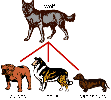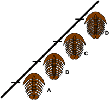 Biospecies:
The
evolution of Modern dogs as observed by quantified changes in DNA over
the last 12,000
years Biospecies:
The
evolution of Modern dogs as observed by quantified changes in DNA over
the last 12,000
years |
 Morphospecies:
The
evolution of rilobites as observed in the fossil record over the last
500 million years Morphospecies:
The
evolution of rilobites as observed in the fossil record over the last
500 million years |
 Biospecies:
The
evolution of Modern dogs as observed by quantified changes in DNA over
the last 12,000
years Biospecies:
The
evolution of Modern dogs as observed by quantified changes in DNA over
the last 12,000
years |
 Morphospecies:
The
evolution of rilobites as observed in the fossil record over the last
500 million years Morphospecies:
The
evolution of rilobites as observed in the fossil record over the last
500 million years |
Photographs courtesy of the University of
California Museum of
Paleontology:
(http://evolution.berkeley.edu/)